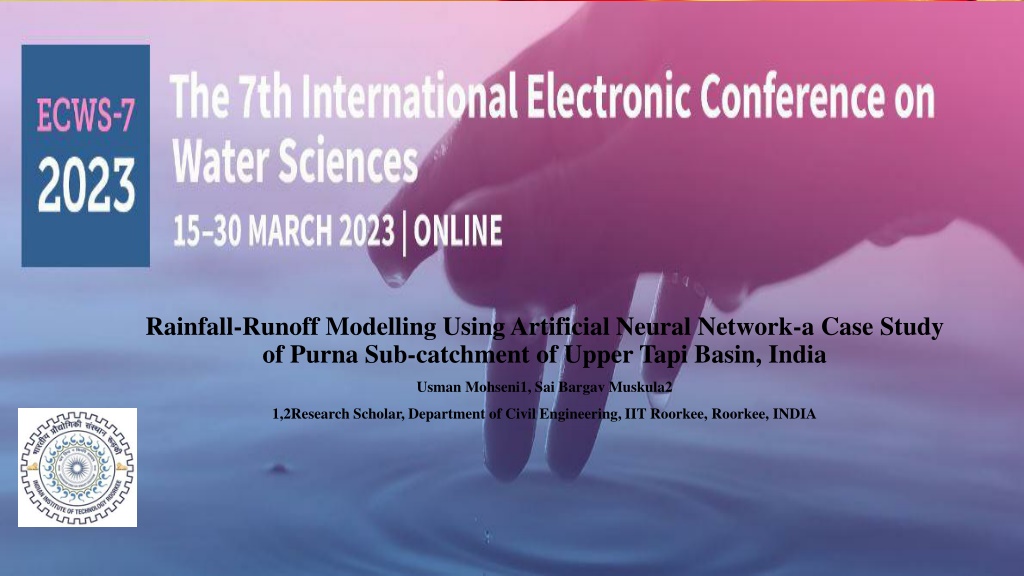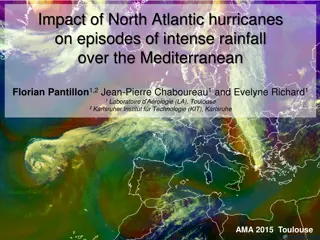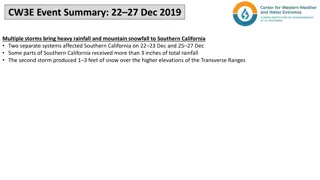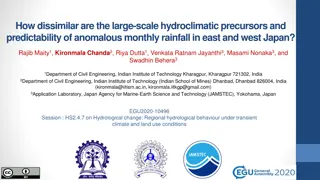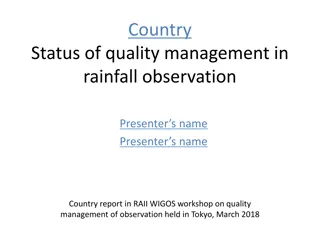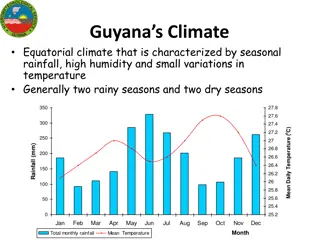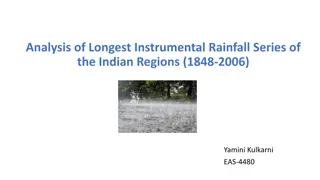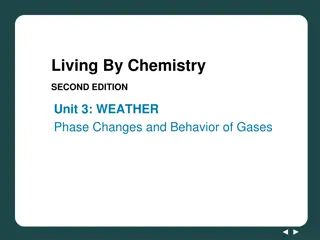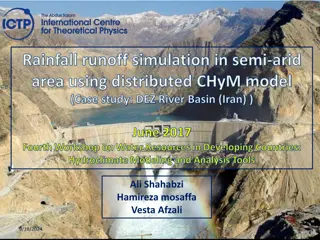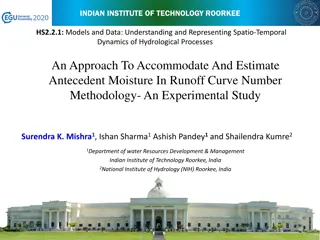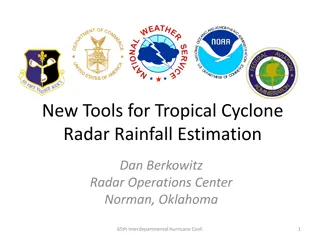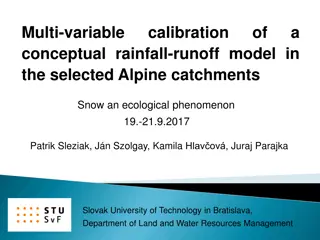Rainfall-Runoff Modelling Using Artificial Neural Network: A Case Study of Purna Sub-catchment, India
Rainfall-runoff modeling is crucial in understanding the relationship between rainfall and runoff. This study focuses on developing a rainfall-runoff model for the Upper Tapi basin in India using Artificial Neural Networks (ANNs). ANNs mimic the human brain's capabilities and have been widely used in hydrological modeling. The objective is to compare different neural network types and training algorithms to enhance hydrological forecasting. Literature review highlights various studies using ANN techniques for rainfall-runoff modeling across the globe.
Download Presentation

Please find below an Image/Link to download the presentation.
The content on the website is provided AS IS for your information and personal use only. It may not be sold, licensed, or shared on other websites without obtaining consent from the author. Download presentation by click this link. If you encounter any issues during the download, it is possible that the publisher has removed the file from their server.
E N D
Presentation Transcript
Rainfall-Runoff Modelling Using Artificial Neural Network-a Case Study of Purna Sub-catchment of Upper Tapi Basin, India Usman Mohseni1, Sai Bargav Muskula2 1,2Research Scholar, Department of Civil Engineering, IIT Roorkee, Roorkee, INDIA
INTRODUCTION Rainfall-runoff modelling is one of the most prominent hydrological models used to examine the relation between rainfall and runoff (Namara et al., 2020). These methods can be divided into two categories: (i) conceptual models that take into account the physics of the underlying process, and (ii) data-driven models that learn and behave based on the information in the data without taking into account the physics of the system (J. Chen &Adams, 2006). The process of rainfall-runoff is highly nonlinear and incredibly complex, and because it is interconnected with various subprocesses involved in the hydrologic cycle (Zhang & Govindaraju, 2000).
INTRODUCTION TO ANN Artificial Neural Networks (ANNs) are data-processing systems that mimic the human brain's capabilities(Kisi et al., 2013). ANN architecture consists of three layers i.e. input layer, hidden layer and output layer Artificial neural network (ANN) models, sometimes known as black-box models, have been effectively employed for simulating complicated hydrological phenomena (Kumar et al., 2011). ANN models have been extremely prevalent in the domains of hydrology, water resources and watershed (Orimi et al., 2015).
OBJECTIVES OF THE STUDY To develop a rainfall-runoff model for Upper Tapi using Artificial Neural Networks Technique. To compare ANN rainfall-runoff models developed using nntool with different neural network types i.e., FFBPNN and CFBPNN. To compare ANN rainfall-runoff models trained using LM, BR and SCG algorithms. This study attempts to improve hydrological forecasting and to determine which models best suit rainfall-runoff modelling.
LITERATURE REVIEW (Mitra & Nigam, 2021) (Romlay et al., 2019) (Nayak et al., 2013) (Dumka & Kumar, 2021) (Sarkar & Kumar, 2012) (Fatih et al., 2019) (Mahsa et al., 2021) (Nemade et al., 2012) (Hussain et al., 2019) (Poonia & Tiwari, 2020) (Kalteh, 2008) (Asadi et al., 2019) (Dey, 2020) (Senthil Kumar et al., 2005) (Patel & Joshi, 2017) (Obasi et al., 2020) (Rajurkar et al., 2004) (Hussain et al., 2017) (Vidyarthi et al., 2020) (Joshi, 2001) (Tayebiyan et al., 2016) (Yadav et al., 2020) (Mittal, 1943) (Sinha et al., 2015) (Samantaray & Sahoo, 2020) (Chen et al., 2013) (Samantaray et al., 2019) (Bakshi & Bhar, 2012)
CLOSURE OF REVIEW: Various rainfall-runoff modelling studies using ANN technique have been conducted in various parts of the world. The above literature review helped to provide an understanding of the Methodology adopted for rainfall-runoff modelling. The literature review shows, the ANN as a widely used for R-R modelling and hence the current study adopted this model.
STUDY AREA & DATA COLLECTION The current study area comprises a portion of the Upper Tapi Basin known as the Purna sub- catchment. The area lies between Maharashtra and Madhya Pradesh, between latitudes of 20 09'N to 22 03'N and longitudes of 75 56'E to 78 17 E. The mean annual precipitation in the chosen area varies from 833 to 990 mm. Figure 1. Index Map of Study Area.
METHODOLOGY Data Collection: Import Data: Creating Network: Number of Neurons: Network Training: Result: Retraining: Model Evaluation: Figure 2. Flow chart of NNTOOL
Data Collection Neural Fitting App Data Selection: Validation and Test: Network Architecture: Select Algorithm: Train Network: Retrain: Output: Figure 3. Flow chart of nnstart
MODEL DEVELOPMENT The ANN contains three layers such as an input layer, a hidden layer and an output layer. Figure 4. ANN Model
MODEL USING NNTOOL Two different models were developed, i.e., Feed Forward Back Propagation Neural Network (FFBPNN) Cascade Forward Back Propagation neural network (CFBPNN) with three different architecture (6-2-1, 6-3-1 and 6-4-1) using several combinations of transfer functions i.e. (transig, logsig and purelin) along with two sets of neurons 10 and 20 and then compared their capability for estimation of flow for the period 1981-2016. (FFBPNN): FFBPNN as the training method is a popular training technique that is commonly used to model hydrologic problems. Figure 5 depicts the structure of the FFBPNN. Figure 5. FFBPNN 3 Layer Model.
(CFBPNN): Cascade Forward neural networks are similar to FFNNs, except they have a weighted link from the input to each layer, which is then connected to subsequent layers. In CFBPNN, neurons in one layer are responsible for computing and updating the weights of all layers in front of them. This model is similar to FFBPNN, except it uses the back propagation algorithm to adjust the weights. Figure 6. CFBPNN 3 Layer Model.
MODEL USING NNSTART In this study, three different algorithms namely Levenberg Marquardt (trainlm), Bayesian Regularization (trainbr) and Scaled Conjugate Gradient (trainscg) were used for model development. Three different models were developed based on the algorithms used. Each model was developed for 36 samples (1981-2016). 70% of the 36 samples are used for training, 15% for validation, and 15% for testing. The number of Neurons adopted by each model were 10,20,30,40,50 and 60 for better performance of the network during training. Finally, all the models were compared based on different model performance evaluation criteria and demonstrated the best model.
ALGORITHMS USED Levenberg Marquardt: This algorithm is quick but consumes more memory. Figure 7. The Architecture of Levenberg Marquardt algorithm. Bayesian Regularization: This algorithm takes longer, it can provide strong generalisation for complex, tiny, or noisy datasets. Figure 8. The architecture of Bayesian Regularization algorithm. Scaled Conjugate Gradient: This algorithm uses less memory. Figure 9. The Architecture of Scaled Conjugate Gradient algorithm.
MODELEVALUATION CRITERIA The findings of the ANN model applied in this study were evaluated by means of: Mean square error (MSE): ? ? ?=1 ?(?? ??)2 . (1) MSE = Root mean square error (RMSE): ?.? ? (? ? ? ? )? ? ?=? .(2) RMSE= Regression Coefficient (R): Using Regression Plot between predicted and observed runoff. Where, ?? is the value of predicted runoff ?? is the value of observed runoff ?(i) is the n estimated runoff value Q(i) is the n observed runoff value
RESULTS & DISCUSSION FFBPNN: Table 2 contains the inclusive outcomes. Table 2. Results of FFBPNN for Yerli station. Transfer Network Number of Neurons MSE RMSE R Function Architecture Transig Transig Transig Transig Transig Transig Logsig Logsig Logsig Logsig Logsig Logsig purelin purelin purelin purelin purelin purelin 6-2-1 6-3-1 6-4-1 6-2-1 6-3-1 6-4-1 6-2-1 6-3-1 6-4-1 6-2-1 6-3-1 6-4-1 6-2-1 6-3-1 6-4-1 6-2-1 6-3-1 6-4-1 10 10 10 20 20 20 10 10 10 20 20 20 10 10 10 20 20 20 0.7905 0.6872 0.6618 0.6028 0.5750 0.4982 1.2126 1.0872 0.9861 0.9812 0.9794 0.9713 1.3811 1.2972 1.1988 1.1697 1.0836 0.9891 0.8891 0.8289 0.8135 0.7764 0.7582 0.7056 1.1011 1.0426 0.9930 0.9905 0.9896 0.9532 1.1752 1.1389 1.0948 1.0815 1.0409 0.9945 0.94204 0.91321 0.92072 0.94418 0.93744 0.96213 0.94575 0.91362 0.83050 0.93820 0.94116 0.95182 0.77560 0.81533 0.88452 0.77055 0.86730 0.90754
The transig transfer function with architecture 6-4-1 gives better results in the current study. Figure 10 depicts the best regression plot. Figure 10. Regression plot for FFBPNN Transig 6-4-1 model.
CFBPNN While considering 6-2-1, 6-3-1, and 6-4-1 architectures, the transig function provides the best value for performance. The most effective model architecture for the Transig function is 6-4-1, which has MSE values of 0.8813, the value of RMSE 0.9387, and the value of R 0.96096. Table 3. Results of CFBPNN for yerli station Transfer Network Number of MSE RMSE R Function Transig Transig Transig Transig Transig Transig Logsig Logsig Logsig Logsig Logsig Logsig Purelin Purelin Purelin Purelin Purelin Purelin Architecture 6-2-1 6-3-1 6-4-1 6-2-1 6-3-1 6-4-1 6-2-1 6-3-1 6-4-1 6-2-1 6-3-1 6-4-1 6-2-1 6-3-1 6-4-1 6-2-1 6-3-1 6-4-1 Neurons 10 10 10 20 20 20 10 10 10 20 20 20 10 10 10 20 20 20 1.6720 1.5852 1.5169 1.4723 1.0288 0.8813 1.2124 1.0696 0.9713 0.9644 0.9277 0.8904 1.5135 1.3866 1.2052 1.1745 1.0289 0.9916 1.2930 1.2590 1.2316 1.2134 1.0142 0.9387 1.1010 1.0342 0.9855 0.9829 0.9631 0.9436 1.2302 1.1775 1.0978 1.0837 1.0143 0.9957 0.91317 0.91972 0.92880 0.92438 0.94060 0.96096 0.92847 0.90271 0.89329 0.90213 0.93750 0.94575 0.76575 0.82150 0.89772 0.76613 0.86520 0.98270
The transig transfer function with architecture 6-4-1 gives better results in the current study. Figure 11 depicts the best regression plot. Figure 11. Regression plot for CFBPNN Transig 6-4-1 model.
NNSTART Table 3 shows the yerli station results for ANN trained by LM, BR, and CGS. The values based on R, MSE, and RMSE are used to characterize the optimum network architecture. The best number of neurons in the hidden layer and the best type of model are displayed in the best configuration column for each unique learning algorithm on the yerli station. Table 4. Results of nnstart for yerli station. Algorithm Number of MSE RMSE R Neurons LM 10 0.9774 0.9886 0.89887 LM 20 0.8557 0.9250 0.90763 LM 30 0.7279 0.8531 0.95057 BR 10 1.1745 1.0837 0.85428 BR 20 0.9669 0.9833 0.91349 BR 30 0.8133 0.9018 0.92790 CGS 10 1.7262 1.3138 0.91291 CGS 20 1.1680 1.0807 0.92185 CGS 30 0.9086 0.9532 0.94573
According to the findings, the ANN trained using LM attained the lowest value of MSE with the fewest number of iterations. However, ANN is trained by BR achieved a good MSE value, but it required the most iterations and had a propensity to overfit. ANN trained using CGS, on the other hand, achieves the maximum number of MSE values with the fewest iterations. Figure 12 Shows the best regression plot for the LM algorithm with 30 neurons. Figure 12. Regression plot for LM algorithm with 30 Neurons.
CONCLUSION Using the NNTOOL for the Transig function in FFBPNN, the most prominent model architecture is 6-4-1, which has MSE values of 0.4982, a value of RMSE 0.7056, and the value of R 0.96108. The 6-4-1 model architecture for the Transig function is the most effective for CFBPNN, with MSE values of 0.8813, RMSE values of 0.9387, and R values of 0.96096. Using nnstart three different algorithms LM, BR and CGS were used to predict yearly runoff. . Among the three, LM trained the algorithm with 30 neurons is the best model with MSE values of 0.7279, RMSE values of 0.8531, and R values of 0.95057. According to the findings, FFBPNN predicts better results than CFBPNN, and the LM algorithm stands out among the other algorithms. The current work contributes to policymakers' ability to design successful flood management measures in the near future by providing vital information on rainfall-runoff modeling at a regional scale.
REFERENCES A.M.Kalteh. (2008). Caspian Journal of Environmental Sciences. Caspian Journal of Environmental Sciences, 6(1), 53 58. Asadi, H., Shahedi, K., Jarihani, B., & Sidle, R. C. (2019). Rainfall-runoff modelling using hydrological connectivity index and artificial neural network https://doi.org/10.3390/w11020212 Bakshi, S., & Bhar, K. K. (2012). Estimation of Discharge in Rivers using ANN Modeled Rating Curves. Journal of The Institution of Engineers (India): Series A, 93(3), 181 186. https://doi.org/10.1007/s40030-013-0020-4 Chang, T. K., Talei, A., Quek, C., & Pauwels, V. R. N. (2018). Rainfall-runoff modelling using a self-reliant fuzzy inference network with flexible structure. Journal of Hydrology, 564(July), 1179 1193. https://doi.org/10.1016/j.jhydrol.2018.07.074 Chen, J., & Adams, B. J. (2006). Integration of artificial neural networks with conceptual models in rainfall- runoff modeling. Journal of Hydrology, 318(1 4), 232 249. https://doi.org/10.1016/j.jhydrol.2005.06.017 Chen, S. M., Wang, Y. M., & Tsou, I. (2013). Using artificial neural network approach for modelling rainfall- runoff due to typhoon. Journal of Earth System Science, 122(2), 399 405. https://doi.org/10.1007/s12040-013- 0289-8 Dey, K. K. (2020). A rainfall-runoff model using artificial neural networks for the district of Bankura in a time of climate change. Indian Journal of Science https://doi.org/10.17485/ijst/v13i33.816 approach. Water (Switzerland), 11(2). and Technology, 13(33), 3364 3376.
REFERENCES Nayak, D. R., Mahapatra, A., & Mishra, P. (2013). A Survey on Rainfall Prediction using Artificial Neural Network. Int. J. Comput. Appl, 72(16), 32 40. Nemade, P. S., Gupta, P. V., & Bhoite, P. A. (2012). Comparative Rainfall Prediction Analysis Year 2012 for Indore ( MP ) Region , India by Using Artificial Neural Network. 3(5), 3 6. Orimi, M. G., Farid, A., Amiri, R., & Imani, K. (2015). Cprecip parameter for checking snow entry for forecasting weekly discharge of the Haraz River flow by artificial neural network. Water Resources, 42(5), 607 615. https://doi.org/10.1134/S0097807815050073 Patel, A. B., & Joshi, G. S. (2017). Modeling of Rainfall-Runoff Correlations Using Artificial Neural Network-A Case Study of Dharoi Watershed of a Sabarmati River Basin, India. Civil Engineering Journal, 3(2), 78 87. https://doi.org/10.28991/cej-2017-00000074 Rajurkar, M. P., Kothyari, U. C., & Chaube, U. C. (2004). Modeling of the daily rainfall-runoff relationship with artificial neural network. Journal of Hydrology, 285(1 4), 96 113. https://doi.org/10.1016/j.jhydrol.2003.08.011 Samantaray, S., & Sahoo, A. (2020). Prediction of runoff using BPNN, FFBPNN, CFBPNN algorithm in arid watershed: A case study. International Journal of Knowledge-Based and Intelligent Engineering Systems, 24(3), 243 251. https://doi.org/10.3233/KES-200046 Tayebiyan, A., Mohammad, T. A., Ghazali, A. H., & Mashohor, S. (2016). Artificial neural network for modelling rainfall-runoff. Pertanika Journal of Science and Technology, 24(2), 319 330
